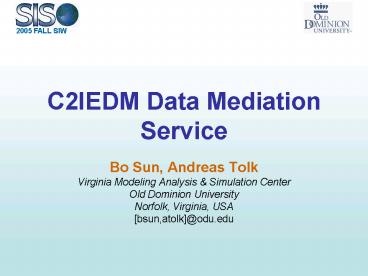C2IEDM Data Mediation Service PowerPoint PPT Presentation
1 / 25
Title: C2IEDM Data Mediation Service
1
C2IEDM Data Mediation Service
- Bo Sun, Andreas Tolk
- Virginia Modeling Analysis Simulation Center
- Old Dominion University
- Norfolk, Virginia, USA
- bsun,atolk_at_odu.edu
2
Outline
- Motivation
- What do I do with my data models in case of
C2IEDM mandates? - Data Mapping
- Preparation
- Documentation
- VV
- Implementation
- Model Based Data Management
- Implementing Data Mediation Services
3
Motivation
- Why should I Care?
- What do I do with my data models in case of
C2IEDM mandates?
4
Why care about Data Mediation
- Global Information Grid (GIG) and other
Service-oriented Architectures are likely to
become the backbone of future distributed
applications - Joint Command and Control
- Future Combat Systems
- NATO Allied Command Control System
- General Challenge Composable Services
- How do I ensure that I understand other services
- How do I ensure that other services understand me
5
How do I migrate my components
- Rewrite everything using a common model
- Cost prohibited
- Most applications have task-tailored views
- Enterprise-wide data model not feasible
- Establish necessary connections to other
services - Point-to-point solutions (2n challenge)
- Only feasible for existing solutions
- Leaves interpretation to the implementer
- Data Mediation Services
- Based on Common Understanding
6
Data Mediation Service Vision
7
Current SolutionDDMS Primary Category Sets
DoD Discovery Metadata Specification
(DDMS) National Security Information Sharing
Standards for Resource Metadata Application
Profile for Discovery (NSISS RMAPD)
8
Data Mapping
- Preparation Phase
- Documentation Phase
- VV Phase
- Implementation Phase
9
Data Mapping
- Data Mapping is the Conceptual Mapping.
- Mapping Complexity depends on relational database
complexity of both source and target data model. - Data Mapping includes four phases
Data
Validation and Verification
Implementation
Documentation
Preparation
10
Preparation Phase
- Use a Consistent Method for source and target
- IDEF1X
- Content attributes
- Structure attributes (keys, foreign keys)
- Identify Business Objects
- Analyze foreign keys
- Identify exchange dependencies
- Identify first mappings on Conceptual Level
- Similar properties and concepts
11
Documentation Phase
- Document the conceptual mappings
- Top-down mapping
- Document additional properties needed
- Bottom-up mapping
- Document the resulting key dependencies
- Business-object to business-object mapping
- Applicable tools
- Excel
- Property and propertied concept matrix
12
MS Excel
13
Property and Propertied Concept Matrix
14
Data Validation Verification
- Validation
- Am I doing the correct thing?
- SME (operational/tactical) necessary
- Verification
- Am I doing things correctly
- Are all targeted attributes covered?
- Are all targeted concepts covered?
- Are the functions correct?
- Documentation
- Can another expert understand what I did and why
15
Implementation
- Objective
- Software Layer translating source into target on
the fly - Applicable tools
- Extensible Stylesheet Language Transformation
(XSLT) tools - Additional Function Layers for
- Aggregation
- Disaggregation
- Conditional transformations
- etc.
16
Model Based Data Management
- Common Reference Data Models
- Data Engineering
17
Components of Data Engineering
- Data Administration
- Managing the information exchange needs incl.
source, format, context of validity, fidelity,
and credibility - Data Management
- Planning, organizing and managing of data, define
and standardize the meaning of data as of their
relations
- Data Alignment
- Ensuring that data to be exchanged exist in all
participating systems - Data Transformation
- Technical process of mapping information elements
to each other (often implemented in gateways and
interfaces)
18
Web-based Standards supporting Data Engineering
- XML as the common syntax and format of all
components - Data source registers data description following
the idea of Universal description, discovery, and
integration registries (UDDI) - Mapping of data will be management of tag sets
- After data management using tag set, data
alignment becomes one-to-one comparison - Data management can lead to XSLT schema for data
translation
Potential for Automation of Data Administration,
Data Alignment and Data Translation based on Data
Management
19
Use Common Reference Model
- Use C2IEDM as target and source
- Over 1,500 data elements in app. 200 tables
representing 176 agreed operational IER - If data element is in this pool
- Map data element to C2IEDM
- Else
- Extend C2IEDM (standard necessary)
- Map data element to new element
20
Model-Based Data Management
21
Implementing Data Mediation Services
- Tools
- Web Services
- Feasibility Study
22
Implementation Technologies
- Architecture
- Data Mapping/Data Translation
- Web Service
- Software packages
- MapForce Data Mapping
- Glue Web Service
23
VMASC Reference Implementation
- Advantages
- Efficient
- MapForce is Code Generator
- Glue has Web Service Frame
- Effective
- MapForce is Visual Mapper
- Flexible
- Build a new mediation service in no time at all
24
Mapping Exampleusing MapForce
25
Summary
- Data Mediation cannot be done automatically
- To much SME knowledge necessary
- AI applications can only support
- Common Reference Model is necessary
- Common Namespace
- Gradual alignment
- Common Standards necessary
- Endorse C2IEDM as core solution
- Develop and standardize C2IEDM extension rules

